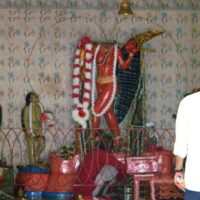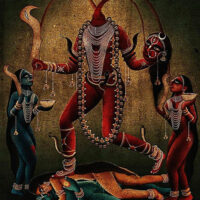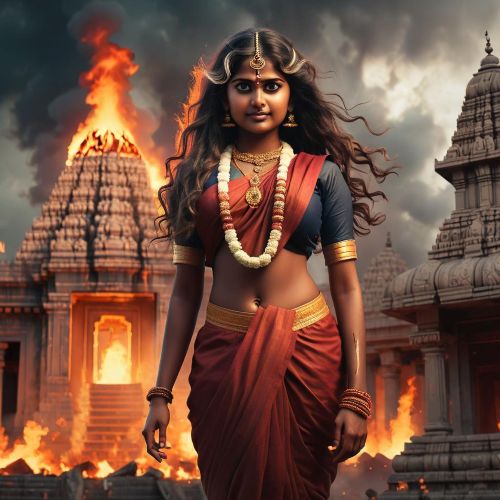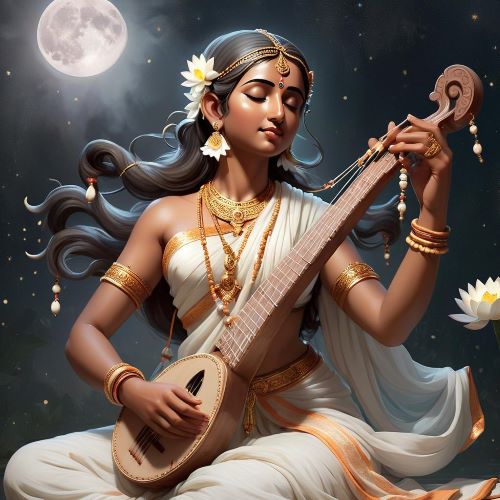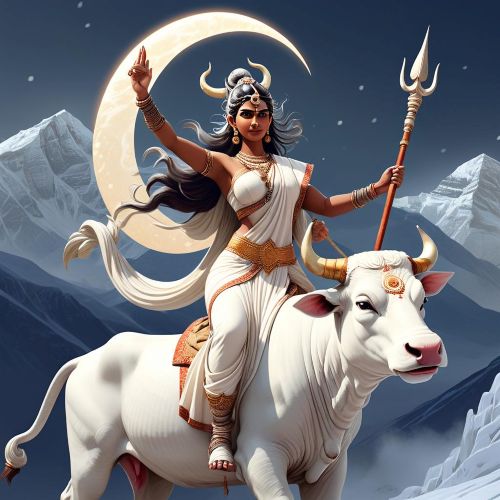Chinnamasta : Goddess of Transformation
Listen
At a glance
| Description | |
|---|---|
| Origin | Indian Mythology |
| Classification | Gods |
| Family Members | N/A |
| Region | India |
| Associated With | Tantric Procedures, Transformation |
Chinnamasta
Introduction
Chinnamasta, the sixth of the ten Mahavidyas in Tantric Hinduism, is among the most striking and esoteric goddesses in Indian spirituality. Her imagery—standing nude, holding her own severed head—instantly sets her apart as a deity of profound paradox. She represents creation and destruction existing in the same breath, the surrender of self to attain liberation, and the balance of life’s opposing forces. Rooted deeply in Shakta traditions, she is equally significant in Hindu and Vajrayana Buddhist Tantra, where her form is revered as a pathway to transcendence. Far from being a symbol of violence, Chinnamasta embodies ultimate self-mastery, the conscious dissolution of ego, and the complete embrace of impermanence.
Physical Traits
The iconography of Chinnamasta is layered with symbolic depth, designed to challenge and enlighten the viewer. She is depicted with either red, orange, or black skin, standing atop the entwined figures of Kamadeva and Rati—gods of love—signifying her dominion over desire and sensual attachment. In one hand, she holds her own severed head, still serene, while the other grasps a blade. From the neck emerge three streams of blood: one consumed by her head, the others by her companions Dakini and Varnini, who flank her as embodiments of her own energy. Adorned with a garland of skulls, serpentine ornaments, and divine jewels, she is framed by the cremation ground or lotus, both of which underline transformation and spiritual rebirth. Every element of her appearance conveys mastery over mortality, liberation from worldly bondage, and the unbreakable continuity of life force.
Family
While Chinnamasta’s mythic origins connect her to the great Hindu Mother Goddess, she stands apart from the nurturing archetype typically associated with Devi. She is an intense and independent form of Parvati, consort of Shiva, though their relationship in her legends is more symbolic than domestic. Her constant companions, Dakini and Varnini, are seen as extensions of her divine essence, serving both as attendants and representations of the energies she governs—ferocity and nourishment. In some tantric narratives, she is born from Parvati’s compassion and wrath combined, offering her own blood to satisfy her companions’ hunger, an act that signifies both sacrifice and abundance.
Other names
Across traditions, Chinnamasta is known by several names that reflect her many facets. In Sanskrit texts, Chhinnamastika translates directly to “she whose head is severed,” capturing the essence of her form. In certain Tantric scriptures, she appears as Prachanda Chandika, “the fiercely intense goddess,” emphasizing her wrathful power. Within Tibetan Vajrayana Buddhism, she manifests as Chinnamunda, a form of the goddess Vajrayogini, symbolizing wisdom beyond duality. In the Sadhanamala, she is Sarvabuddha, “all-awakened,” highlighting her enlightened state, while in other esoteric works, titles like Sarvasiddhi and Sarvabuddhi connect her to accomplishment and omniscience. These varied epithets underscore her integration into multiple spiritual lineages and her adaptability across cultures and regions.
Powers and Abilities
Chinnamasta’s power is not rooted in physical might but in spiritual transformation. Her act of self-decapitation is a profound metaphor for cutting away the ego, the single greatest barrier to enlightenment. By feeding her attendants with her blood, she represents the endless circulation of life force, the sharing of prana, and the divine reciprocity between goddess and devotee. Standing upon the gods of love, she asserts mastery over desire while acknowledging its role in creation, illustrating the tantric ideal of transcendence through, rather than avoidance of, worldly forces. She is associated with the awakening of kundalini energy, where her flowing blood symbolizes the upward surge of spiritual power through the body’s chakras. Devotees believe she grants siddhis—supernatural abilities—ranging from spiritual insight to control over sensory impulses. Above all, she is seen as a destroyer of ignorance, guiding those ready for radical self-realization.
Modern Day Influence
In today’s world, Chinnamasta remains a powerful yet esoteric presence, especially within Tantric practice in regions like Bengal, Nepal, and Himachal Pradesh. While not as widely worshipped as Kali or Durga, she commands deep reverence in select shrines such as the Chintpurni Temple in Himachal Pradesh and the Chhinnamasta Temple in Jharkhand, where her festivals draw pilgrims seeking liberation from fear and attachment. In modern spirituality, her paradoxical nature has inspired yogic interpretations, feminist discourse, and psychological studies, often positioning her as an archetype for self-empowerment and ego dissolution. Artists and writers have embraced her imagery in works exploring identity, transformation, and the human relationship with mortality. Though her worship remains specialized, her symbolism—fearless, self-sacrificing, and transformative—continues to resonate with seekers drawn to the deeper, more intense pathways of spiritual growth.
Related Images
Source
Benard, E. A. (1994). Chinnamasta: The aweful Buddhist and Hindu Tantric goddess. Motilal Banarsidass. https://archive.org/details/chinnamastaawefu0000bena
Vedic Feed. (2022, March 10). Chinnamasta – The headless Tantric goddess of transformation. https://vedicfeed.com/chinnamasta-goddess-of-transformation/
Hinduism Facts. (2025). Chinnamasta Devi – The goddess who cut her head. https://hinduismfacts.org/hindu-gods-and-goddesses/chinnamasta/
Historified. (2024, June 4). Chinnamasta: The self-decapitated goddess. https://historified.in/2024/06/04/chinnamasta-the-self-decapitated-goddess/
SivaSakti. (n.d.). Chinnamasta – The headless goddess of transformation. https://www.sivasakti.com/tantra/dasa-maha-vidya/chinnamasta-5/
Kalitantra. (n.d.). Chinnamasta – Worship of goddess to fight fear and anxiety. https://www.kalitantra.in/chinnamasta.php
Wikipedia contributors. (2025). Chhinnamasta. Wikipedia. https://en.wikipedia.org/wiki/Chhinnamasta
Frequently Asked Questions
What is lorem Ipsum?
I am text block. Click edit button to change this text. Lorem ipsum dolor sit amet, consectetur adipiscing elit. Ut elit tellus, luctus nec ullamcorper mattis, pulvinar dapibus leo.
What is lorem Ipsum?
I am text block. Click edit button to change this text. Lorem ipsum dolor sit amet, consectetur adipiscing elit. Ut elit tellus, luctus nec ullamcorper mattis, pulvinar dapibus leo.
What is lorem Ipsum?
I am text block. Click edit button to change this text. Lorem ipsum dolor sit amet, consectetur adipiscing elit. Ut elit tellus, luctus nec ullamcorper mattis, pulvinar dapibus leo.
What is lorem Ipsum?
I am text block. Click edit button to change this text. Lorem ipsum dolor sit amet, consectetur adipiscing elit. Ut elit tellus, luctus nec ullamcorper mattis, pulvinar dapibus leo.
What is lorem Ipsum?
I am text block. Click edit button to change this text. Lorem ipsum dolor sit amet, consectetur adipiscing elit. Ut elit tellus, luctus nec ullamcorper mattis, pulvinar dapibus leo.




